Transferts monétaires et mobilité humaine
Les transferts monétaires sont souvent utilisés lors de crises afin de répondre aux besoins des personnes migrantes. Dans cette page, vous trouverez des ressources sur les transferts monétaires et la migration.

La Croix-Rouge se prépare à fournir une aide humanitaire aux migrant·es de la caravane sur le point de quitter le Honduras pour le Guatemala.
©Johannes Chinchilla / FICR.
Conflits, crises économiques et catastrophes sont autant de raisons ayant contraint des personnes à fuir et à traverser des frontières dans des conditions éprouvantes et risquées, en quête de sécurité et de moyens de subsistance. En 2020, le nombre de personnes déplacées de force s’est envolé au niveau sans précédent de plus de 80 millions de personnes, soit près du double du nombre enregistré il y a une dizaine d’année. Cette tendance s’aggrave et les effets du changement climatique menacent de déplacer jusqu’à 200 millions de personnes d’ici 2050.
L’assistance monétaire est de plus en plus utilisée afin de répondre aux besoins des personnes en situation de déplacement. On y a eu recours à grande échelle dans différents contextes de migration, en Europe en 2015 jusqu’au Venezuela pour « los caminantes ». Elle a également été utilisée dans d’autres crises migratoires, notamment en Amérique centrale, au Sahel, en Méditerranée et dans la Corne de l’Afrique. L’assistance monétaire est à l’heure actuelle l’une des principales formes d’aide apportée aux populations déplacées en Ukraine et dans les pays voisins.
Il existe une myriade de perspectives et de définitions concernant le mot « migrant·e » et la façon dont les humanitaires doivent agir. C’est pourquoi nous ne choisissons pas une définition unique pour le moment, étant donné que les discussions sur l’assistance monétaire et la migration en sont encore à leurs prémices et que le langage évolue encore.
Documenter et partager les données probantes donnera lieu à des interventions plus efficaces. Cette page contient une sélection de ressources utiles concernant la migration et le recours à l’assistance monétaire. Elle sera mise à jour au fil des discussions ayant lieu dans les espaces humanitaires des transferts monétaires.
Priorités actuelles
Afin de contribuer aux progrès relatifs à cet enjeu, nous nous engageons à :
- soutenir la création de données probantes aux niveaux régional et mondial ;
- contribuer aux solutions pratiques visant à mettre en œuvre les transferts monétaires auprès des personnes migrantes ;
- organiser des discussions sur les enjeux majeurs basées sur des données probantes.
Contenu récent
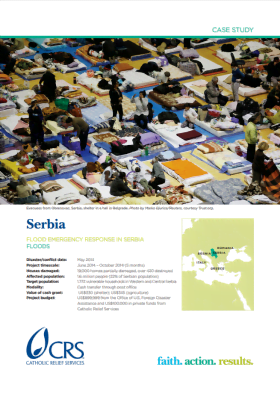
Using Cash for Shelter: Flood Emergency Response in Serbia
Case Study
The devastating floods that affected the Balkans in May 2014 affected 1.6 million people, 22 percent of Serbia’s population, and have set the country’s economic development back decades. Catholic Relief Services (CRS) conducted rapid assessments in 13 villages in the municipalities of Šabac, Valjevo,...
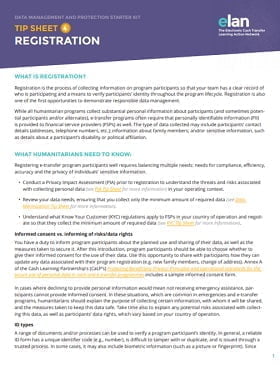
Data management and protection starter kit: Tip sheet 4: Registration
Guidelines and Tools
Registration is the process of collecting information on program participants so that your team has a clear record of who is participating and a means to verify participants’ identity throughout the program lifecycle. Registration is also one of the first opportunities to demonstrate responsible data...
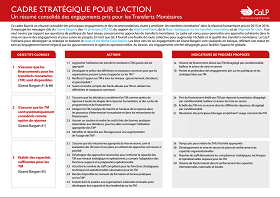
Cadre Strategique Pour L’action
Rapport
Un résumé consolidé des engagements pris pour les Transferts Monétaires
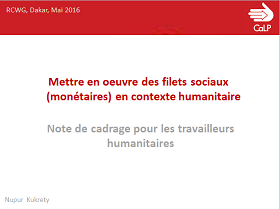
Mettre en oeuvre des filets sociaux (monétaires) en contexte humanitaire
Rapport
Note de cadrage pour les travailleurs humanitaires

What to know: working with humanitarians on e-cash programs
Report
International humanitarian assistance rose to a record US$24.5 billion in 2014. The 2015 Global Humanitarian Assistance Report indicated that over US$200 million of this was used in cash and voucher programs. An increasing number of humanitarian actors have begun to deliver cash electronically, through...

International Cash based assistance
Report
For more than 60 years, the United States provided assistance to food-insecure countries primarily in the form of food commodities procured in the United States and transported overseas. In recent years, the U.S.government has increasingly provided food assistance in the form of cash transfers or food...

ELAN Vocabulary and Usage
Guidelines and Tools
As e-transfer programs, technologies and products develop, key terms, phrases and working definitions are evolving alongside them. At the moment, these words and phrases are rarely standardized, and often hold unique meanings within different contexts and to different stakeholders. In order to facilitate...
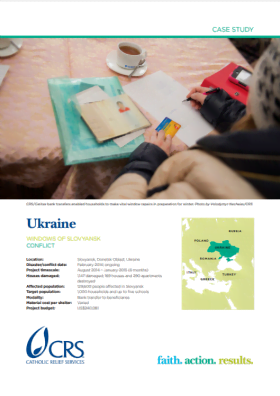
Using Cash for Shelter: Windows of Slovyansk
Case Study
After pro-Russian separatists declared republics in Eastern Ukraine in April 2014, Slovyansk became a focal point of fighting between government forces and rebels until the Ukrainian military retook the city in early July. Slovyansk saw the heaviest fighting of any urban area and many city dwellers fled....
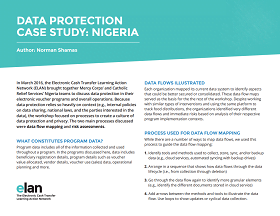
Data Protection Case Study: Nigeria
Report
In March 2016, the Electronic Cash Transfer Learning Action Network (ELAN) brought together Mercy Corps’ and Catholic Relief Services’ Nigeria teams to discuss data protection in their electronic voucher programs and overall operations. Because data protection relies so heaviliy on context (e.g.,...

Data management and protection starter kit: Tip sheet 2: Data minimization
Guidelines and Tools
Data minimization is a privacy principle that requires the people collecting data to be intentional about what type of data is collected and how long it is retained. To meet this principle, teams should limit data collection to what is directly relevant and necessary to accomplish a specified purpose. In...

What next for CTP?
Report
What next for CWG for 2016? and how to Ensure bangladesh is ready for CTP at scale, at speed and across sectors by 2018? De-Brief and validation Workshop 25 November 2015

Economic Impacts of Humanitarian Aid
Report
Humanitarian aid – whether in-kind or cash transfers – can have a significant economic impact. Potential positive effects include stimulating demand, supporting regeneration of local businesses, job creation and increased tax revenue for governments. Potential negative effects include price inflation,...

When the Money Runs Out Do Cash Transfers Have Sustained Effects on Human Capital Accumulation
Report
This study examines the medium-term effects of a two year cash transfer program targeted to adolescent girls and young women. Significant declines in HIV prevalence, teen pregnancy, and early marriage among recipients of unconditional cash transfers (UCTs) during the program evaporated quickly two...

Cash and Markets In The WASH Sector
Report
Market based programming is increasingly heralded as having a critical place in the future of humanitarian programming. The proposed benefits of working through existing market systems include improvements to speed, efficiency and effectiveness of programming and increased beneficiary dignity and...

Building on social protection systems for effective disaster response: the Philippines experience
Report
How can social protection systems be used in disasters, as a complement to, or substitute for, humanitarian assistance? Oxford Policy Management led a two-year research project investigating this question, looking at the role of social protection in both mitigating the impact of large-scale shocks and...

Partnering with FSPs to Deliver Cash in Nepal: Top Considerations
Guidelines and Tools
Cash transfers are a proven way to help disaster-affected communities flexibly meet urgent basic needs. Several humanitarian agencies are planning cash transfers to support tens of thousands of Nepali earthquake survivors. While initial responses will likely rely on direct cash in envelopes, cash...
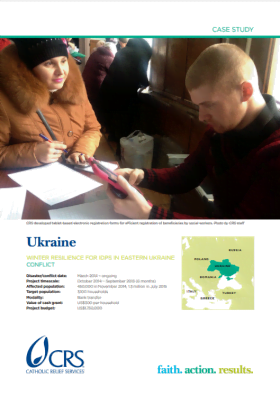
Using Cash for Shelter: Winter Resilience for IDPs in Eastern Ukraine
Case Study
Continued conflict in Eastern Ukraine during 2014 caused internal displacement of over 1.46 million people by September 2015, and another 1,123,800 fled to other countries, according to the United Nations High Commissioner for Refugees. Rapid assessments carried out by Catholic Relief Services found that...
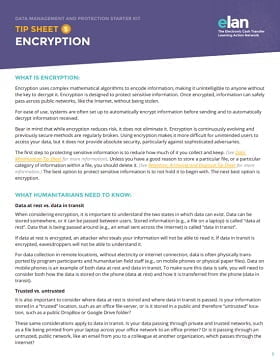
Data management and protection starter kit: Tip sheet 5: Encryption
Guidelines and Tools
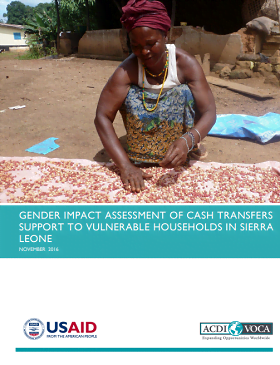
Gender impact assessment of cash transfers support to vulnerable households in Sierra Leone
Report
This report outlines the findings and recommendations from a qualitative assessment carried out to complement and further develop the findings from a recently concluded quantitative study of SNAP+ in order to better understand the driving factors behind behavior during the Ebola crises. The quantitative...

Impact Evaluation of the Multipurpose Cash Assistance Programme
Report
The Syrian crisis is currently in its sixth year, with over one million Syrians still living in Lebanon as refugees. Nearly 60% of all financial resources pledged by UN agencies and INGOs were to secure basic assistance for Syrian refugees, mainly to support them in meeting food and healthcare needs. In...